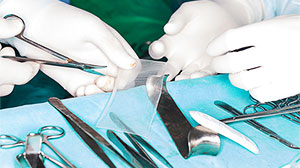Robotic surgery is one of the most effective and least invasive options we offer our hernia patients. In fact, we’re able to do even large hernia repairs with robotic techniques, which benefit patients with smaller “keyhole” incisions and less pain during recovery than traditional open surgery.
A hernia occurs when an internal organ pushes through the muscle or tissue that holds it in place. Hernias can occur in the abdomen, groin, thigh, belly button, upper stomach or in previous surgical incision sites. When a hernia blocks off blood supply to an organ or interferes with its function, it can cause symptoms such as:
- Fever, nausea or vomiting
- Interference with daily activities or exercise
- Pain at the site
Most patients with hernias need regular monitoring to ensure they don’t get worse, and some need surgery to repair the weakened tissue. If you do need surgery, minimally invasive or robotic surgery is a safe, effective option for many patients. Still, it’s important to understand all your options before you and your doctor decide what type of hernia repair surgery is best for you.
Types of hernia repair surgery
Traditional open surgery
This technique involves a large incision extending beyond the size of the hernia. Open surgery is required for very large hernias because we physically move the abdominal wall muscles to access the hernia, and then cover the gap with synthetic mesh to reinforce or strengthen that repair and the abdominal wall. Some patients with severe heart problems or who have a lot of scar tissue from multiple abdominal surgeries can only have open surgery and may not be candidates for minimally invasive options.
Because the incision is larger with open surgery than with minimally invasive surgery, the risk of infection is higher. Patients also will have a longer recovery and longer hospital stay after surgery.
Laparoscopic surgery
Instead of one large incision, laparoscopic, or minimally invasive hernia repair uses multiple keyhole incisions, which are tiny incisions around the hernia. The 5 mm to 8 mm incisions allow the surgeon to insert a small telescope attached to a camera, called a laparoscope, and miniaturized surgical instruments to repair the weakened tissue and insert the mesh reinforcement.
Smaller incisions result in lower infection risk, fewer complications and less pain than traditional open surgery.
Robotic laparoscopic surgery
Robotic laparoscopic surgery is a minimally invasive technique in which the surgeon manipulates robotic arms with instruments at a console instead of manually inserting tiny instruments inside the body. The way the surgeon moves their hands indicates the way the robotic “hands” move, giving the surgeon greater precision and range of motion than during traditional or laparoscopic surgery. During laparoscopic or robotic repair, we use keyhole incisions around the hernia, and a mesh reinforcement patch is put in from behind the abdominal wall. In open surgery, the patch is placed over the hole outside the abdominal wall.
Similar to laparoscopic surgery, robotic surgery has a lower infection risk, less pain and a shorter recovery time than traditional surgery. Patients often can leave the hospital the same day or the next day. In terms of getting back to exercise, we ask patients to hold off on weight training or extreme sports for up to six weeks to allow the repaired tissue to heal properly. But most patients can resume light aerobic activity such as walking within a week.
A note about the mesh used in hernia repair
 There are scary commercials online and on TV stating that hernia repair mesh causes infections. It’s true that when a foreign substance such as mesh is placed in the body, the risk of infection increases. But for the vast majority of hernia repairs, the benefits of the mesh far outweigh the risk. And mesh repairs have a substantially lower risk for additional repair in the future than surgeries done without it.
There are scary commercials online and on TV stating that hernia repair mesh causes infections. It’s true that when a foreign substance such as mesh is placed in the body, the risk of infection increases. But for the vast majority of hernia repairs, the benefits of the mesh far outweigh the risk. And mesh repairs have a substantially lower risk for additional repair in the future than surgeries done without it.
If you need hernia surgery, choose a surgeon who is skilled in all of these techniques. Sometimes, due to a surgeon’s training limitations, patients are given an open repair when a minimally invasive approach could be just as effective. Be sure to ask questions and get a second opinion if a surgeon tells you minimally invasive or robotic surgery is not an option for you.

